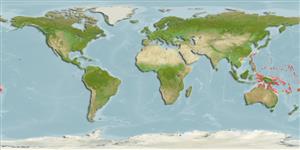Common names from other countries
>
Anguilliformes (Eels and morays) >
Muraenidae (Moray eels) > Uropterygiinae
Etymology: Uropterygius: Greek, oura = tail + Greek pterygion = little wing. Fin (Ref. 45335); oligospondylus: Name from Greek 'oligo' meaning few and 'spondylos' for vertebrae; referring to its lower vertebral count ..
More on authors: Chen, Randall & Loh.
Environment: milieu / climate zone / depth range / distribution range
Écologie
marin benthopélagique; profondeur 0 - 15 m (Ref. 79875). Subtropical
Western Pacific, Taiwan, Solomon Is., and Vanuatu.
Taille / Poids / Âge
Maturity: Lm ? range ? - ? cm
Max length : 53.5 cm TL mâle / non sexé; (Ref. 79875)
Description synthétique
Clés d'identification | Morphologie | Morphométrie
Vertèbres: 100 - 103. This species is distinguished by having the following characters: body color grey, blackish reticular pattern; higher body depth; fewer vertebrae (100-103); teeth on jaw 3 rows, denser dentition, longer teeth; anus close to mid-body point; head length 6.4-7.3 in TL; trunk length 2.7-2.8 in TL; depth at gill opening 12.0-15.5 in TL; eye diameter 21.4-23.3 in HL; snout length 4.9-6.2 in HL (Ref. 79875).
Collected from rocky shores by longline and rotenone (Ref. 79875).
Life cycle and mating behavior
Maturities | Reproduction | Spawnings | Egg(s) | Fecundities | Larves
Loh, K.-H., Chen, I.-S., J.E. Randall and H.-M. Chen, 2008. A review and molecular phylogeny of the moray eel subfamily uropterygiinae (Anguilliformes: Muraenidae) from Taiwan, with descriptiuon of a new species. The Raffles Bull. Zool. 19:135-150. (Ref. 79875)
Statut dans la liste rouge de l'IUCN (Ref. 130435)
CITES (Ref. 128078)
Not Evaluated
Menace pour l'homme
Harmless
Utilisations par l'homme
Outils
Articles particuliers
Télécharger en XML
Sources Internet
Estimates based on models
Preferred temperature (Ref.
115969): 25.4 - 29.3, mean 28.4 (based on 927 cells).
Phylogenetic diversity index (Ref.
82804): PD
50 = 0.5000 [Uniqueness, from 0.5 = low to 2.0 = high].
Bayesian length-weight: a=0.00069 (0.00033 - 0.00144), b=3.12 (2.93 - 3.31), in cm Total Length, based on LWR estimates for this (Sub)family-body shape (Ref.
93245).
Niveau trophique (Ref.
69278): 3.5 ±0.6 se; based on size and trophs of closest relatives
Résilience (Ref.
120179): Milieu, temps minimum de doublement de population : 1,4 à 4,4 années (Preliminary K or Fecundity.).
Fishing Vulnerability (Ref.
59153): Moderate vulnerability (41 of 100).
